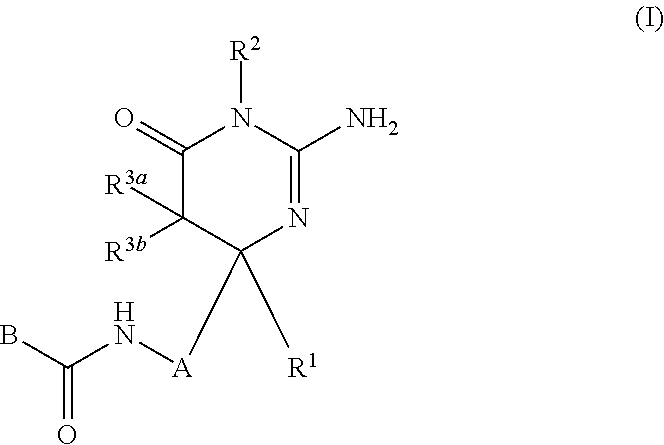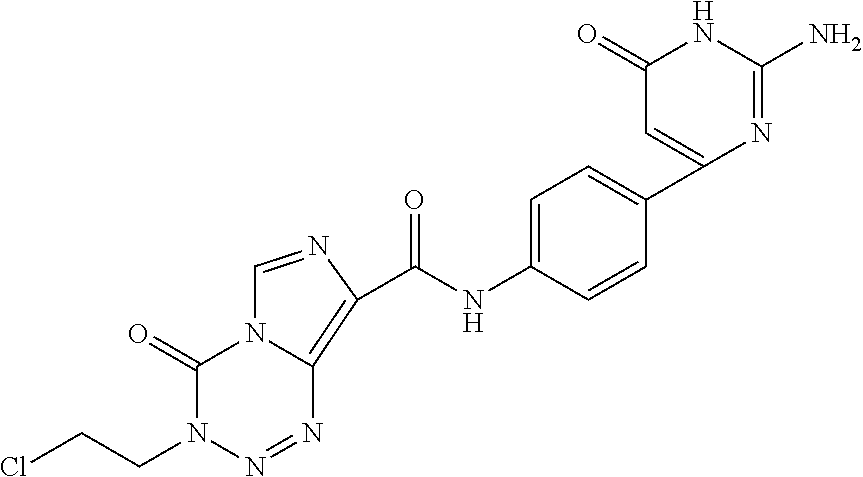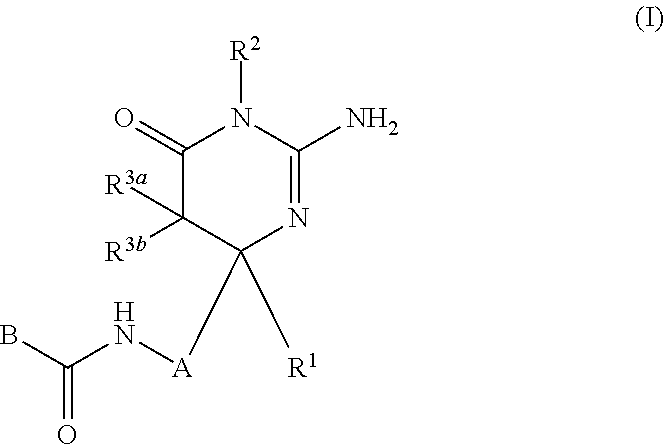2-aminopyrimidin-4-one and 2-aminopyridine derivatives both having bace1-inhibiting activity
a technology of aminopyrimidin and a derivative, which is applied in the direction of biocide, heterocyclic compound active ingredients, drug compositions, etc., to achieve the effect of inhibiting amyloid- production
- Summary
- Abstract
- Description
- Claims
- Application Information
AI Technical Summary
Benefits of technology
Problems solved by technology
Method used
Image
Examples
reference example 1
Synthesis of Fused Cyclic Compound (6)
[0370]
[0371]Compound (1) (1000 mg), dioxane (2 ml), and 28% aqueous ammonia solution (2 ml) were mixed with each other, and the mixture was stirred for 19 hours at 50° C. The reaction solution was concentrated under reduced pressure. Water was added to the residue, and the residue was extracted with ethyl acetate. The extract was dried with anhydrous magnesium sulfate, and the solvent was distilled away under reduced pressure. The residue was subjected to silica gel column chromatography. Compound (2) (476 mg) was thereby obtained.
[0372]1H-NMR (CDCl3) δ: 1.63 (9H, s), 5.04 (2H, br s), 8.03 (1H, s), 8.69 (1H, s).
[0373]Compound (2) (475 mg) was mixed with 3-bromo-2-oxopropanoic acid ethyl ester (1582 mg) in dimethoxyethane (4 ml), and the mixture was stirred for 2.5 hours at 75° C. The reaction solution was diluted with diisopropyl ether. Insoluble matter was collected by filtration, rinsed with diisopropyl ether and hexane, and dried under reduce...
example 1
Synthesis of Compound 35
[0380]
Step 1
[0381]Compound (8) (14.93 g) was dissolved in tetrahydrofuran (100 ml). A 1.6 M solution of n-butyl lithium in hexane (4.4 g) was dropwise added thereto at −78° C., and the mixture was stirred for 30 minutes. Compound (7) (10 g) was added thereto over 30 minutes, and the mixture was further stirred for 30 minutes. The mixture was warmed up to room temperature, and further stirred for 18 hours. The solvent was concentrated under reduced pressure, and the residue was purified by chromatography. Compound (9) (7.5 g) was thereby obtained.
[0382]1H-NMR (CDCl3) δ: 1.3 (3H, t), 2.6 (3H, s), 4.2-4.3 (2H, q), 6.2 (1H, s), 7.5 (1H, t), 7.8 (1H, d), 8.2 (1H, d), 8.3 (1H, s).
Step 2
[0383]Compound (9) (20.0 g) was dissolved in methanol (200 ml) and water (70 ml). Sodium hydroxide (10.2 g) was added thereto, and they were stirred overnight at room temperature. Methanol was removed under reduced pressure, and 1 M hydrochloric acid was added to the product so as to...
example 2
Synthesis of Compound 482
[0399]
Step 1
[0400]Potassium t-butoxide (4.25 g) and 2-butyn-1-ol (10 ml) were added to ice-cold dimethylformamide (10 ml) under nitrogen stream. Compound (18) (1.5 g) was further added thereto. The temperature of the mixture was raised to room temperature, and the mixture was heated and stirred for 8 hours at 65° C. The temperature of the mixture was lowered to room temperature, and 2 M aqueous hydrochloric acid was added thereto. The solvent was then distilled away under reduced pressure. Thereafter, water was added and ultrasound treatment was performed. Compound (19) (1.37 g) was thereby obtained as solid matter.
[0401]1H-NMR (DMSO-d6) δ: 1.84 (3H, s), 5.04 (2H, s), 8.39 (1H, s), 8.79 (1H, s)
Step 2
[0402]Dimethylformamide (2 ml) was added to Compound (19) (104 mg) and HATU (205 mg), and then Compound (20) (73 mg) and triethylamine (92 μl) were added thereto. The mixture was stirred for 1 hour at room temperature, and the reaction solution was concentrated u...
PUM
| Property | Measurement | Unit |
|---|---|---|
| Volume | aaaaa | aaaaa |
| Volume | aaaaa | aaaaa |
| Volume | aaaaa | aaaaa |
Abstract
Description
Claims
Application Information
 Login to View More
Login to View More - R&D
- Intellectual Property
- Life Sciences
- Materials
- Tech Scout
- Unparalleled Data Quality
- Higher Quality Content
- 60% Fewer Hallucinations
Browse by: Latest US Patents, China's latest patents, Technical Efficacy Thesaurus, Application Domain, Technology Topic, Popular Technical Reports.
© 2025 PatSnap. All rights reserved.Legal|Privacy policy|Modern Slavery Act Transparency Statement|Sitemap|About US| Contact US: help@patsnap.com



